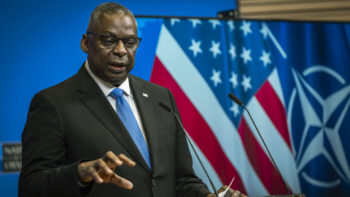We are approaching the presidential primaries, the silliest of the political silly seasons. Magical thinking abounds as candidates appeal to their bases with few constraints on the promises they make or the sentiments they espouse. So it is with defense issues, as the presidential candidates, a group of highly accomplished people (yes, even Donald Trump), have talked about national security in grand generalizations that are sometimes disconnected from reality.
Nevertheless, the outlines of different approaches are emerging. Let’s take a look at what the candidates have said and try to understand what that might mean for the future of defense budgets and programs.
The first thing we can see that there is a tremendous variation in where the candidates stand, from large budget increases proposed by the Republicans, to deep cuts proposed by the Senate’s lone socialist, Bernie Sanders.
All the Republicans support increased spending for defense and establishing a more robust defense posture. There’s lots of talk about rebuilding defenses, reversing budget cuts and having “the most powerful military on the planet” — but there are precious few specifics. Former Florida Gov. Bush, for example, has proposed a detailed program for confronting ISIS but offered little on the budget and specific programs. Former Ohio Gov. John Kasich claims to be a “cheap hawk,” pointing to his support of the 1986 Goldwater-Nichols Act that reorganized the Pentagon. On the other hand, he has called for the Navy to boost the carrier fleet from its current 10 ships to as many as 15 carriers, an immensely expensive undertaking. Generally, Republicans have been particularly supportive of the Navy, which they all identify as being too small.
Former HP CEO Carly Fiorina has been most specific about her proposals and gets a gold star for that. She proposed an Army of 50 brigades, a Navy of 300 to 350 ships, a Marine Corps of 36 infantry battalions and “an upgrade to every leg of the triad” in the most recent Republican presidential debate. Although unattributed, this force structure appears to come from a Heritage Foundation proposal. Heritage argues that, based on historical experience in previous conflicts and the globalization of technology that mitigates the U.S. advantage, a force of this size is needed to carry out the two major war strategy that all recent administrations have adopted, in one form or another.
Although her proposal represents a dramatic change from the current level of the budget and state of the debate, there are arguments in its favor. It’s affordable in the sense that the implied percentage of GDP (3.5%) spent on the military would still be far below Cold War levels — 5 percent to 6 percent in the 1980s and 8 percent to 9 percent in the 1950s). It’s consistent with a shift in public opinion about defense spending, which in the last year has changed from “it’s too big” to “it’s too small.” Spending on the systems mentioned by Fiorina would reestablish the military superiority that the U.S. enjoyed since the end of the Cold War, and it would clearly respond to the challenges of a rising Chinese military, a newly aggressive Russia, and a ruthless ISIS.
The problem, of course, is how to pay for this. Running Fiorina’s program through the CSIS Force Cost Calculator shows it would cost $100 billion more than the president’s 2016 budget proposal (or $135 billion over sequestration level) Since Democrats would demand an equal increase in domestic spending it would, at least in effect, require repeal the Republican’s signature deficit reduction initiative, the Budget Control Act of 2011.
On the left the issues are the inverse. Sen. Bernie Sanders is a socialist. He claims to be a deficit hawk, but not surprisingly, he aims his cuts mainly at defense. When asked about what defense cuts he would make, he points to “Cold War weapons” (a term that is far beyond its expiration date) such as nuclear weapons and carriers. He also cites the need to find efficiencies in defense and to let our allies take up more of the burden. Although these proposals do not add up to a complete defense program, Sanders at least gets credit for identifying some specifics. None of these are outlandish ideas, although the tone of his message is for deep defense cuts. That would imply a much larger shift in programs and strategy than contained in his statements.
- Nuclear weapons have been controversial since their inception, and there has long been debate about how many are needed, but they are now not a big budget item. The most expensive program, replacing the Ohio-class ballistic missile submarines, also has the strongest support among both the left and right because it sustains the most survivable leg of the triad.
- Carriers, although not Cold War weapons, are both very expensive and very useful. A major part of the Navy is shaped around them: the ships themselves, the aircraft that go on them and the escorts that protect them. At $12 billion each, carriers are controversial for a very simple reason — their high cost. They have been enormously useful in crisis response and regional conflicts. There are increasing questions, however, about their survivability against a peer competitor like China or Russia.
- Finding federal government efficiencies is a non-answer, whether it’s from a socialist talking about the defense budget or from conservatives talking about the domestic budget. Efficiencies, like waste, are in the eyes of the beholder. Is capping military pay an efficiency or a betrayal of trust? Is cutting civilians an efficiency or a hollowing out of organizations? True efficiencies, that is, cuts that reduce costs but do not reduce output, are rare. Base closings are one of the few that most analysts would agree on.
- Getting our allies to do more has long been a US policy goal. Before 911, America contributed half of NATO spending. Today America pays 75 percent of the alliance’s total.
Former Secretary of State Hillary Clinton takes a cautious middle approach as befits a frontrunner more concerned about avoiding mistakes than articulating clear policies. Some of her policies could have come from Republican talking points — “standing up to Putin”, “holding China accountable”, “making sure our military is on the cutting edge”. Interestingly, the only specific program mentioned on her web site is not American but Israeli, the Iron Dome missile defense system, which she supports. Reportedly, Clinton is positioning herself as a tougher version of Obama. What this means for Pentagon budgets and programs is unclear, maybe just muddling through with the same strategy and the same level of resources. Whether that strategy is sustainable with the current resources is hotly debated. The Joint Chiefs of Staff have been emphatic that the level in the president’s budget is the minimum needed to execute the national and military strategy. As an increasingly effective challenger, Sanders is pushing Clinton to the left, so she may not be able to keep strategy and resources aligned.
Mark Cancian, a former top defense budget analyst at the Office of Managment and Budget under President Obama, is a defense analyst at the Center for Strategic and International Studies.
This is the first of periodic analyses we’ll run as the 2016 presidential campaigns mature and defense proposals become more specific. The Editor
Lockheed wins competition to build next-gen interceptor
The Missile Defense Agency recently accelerated plans to pick a winning vendor, a decision previously planned for next year.




























